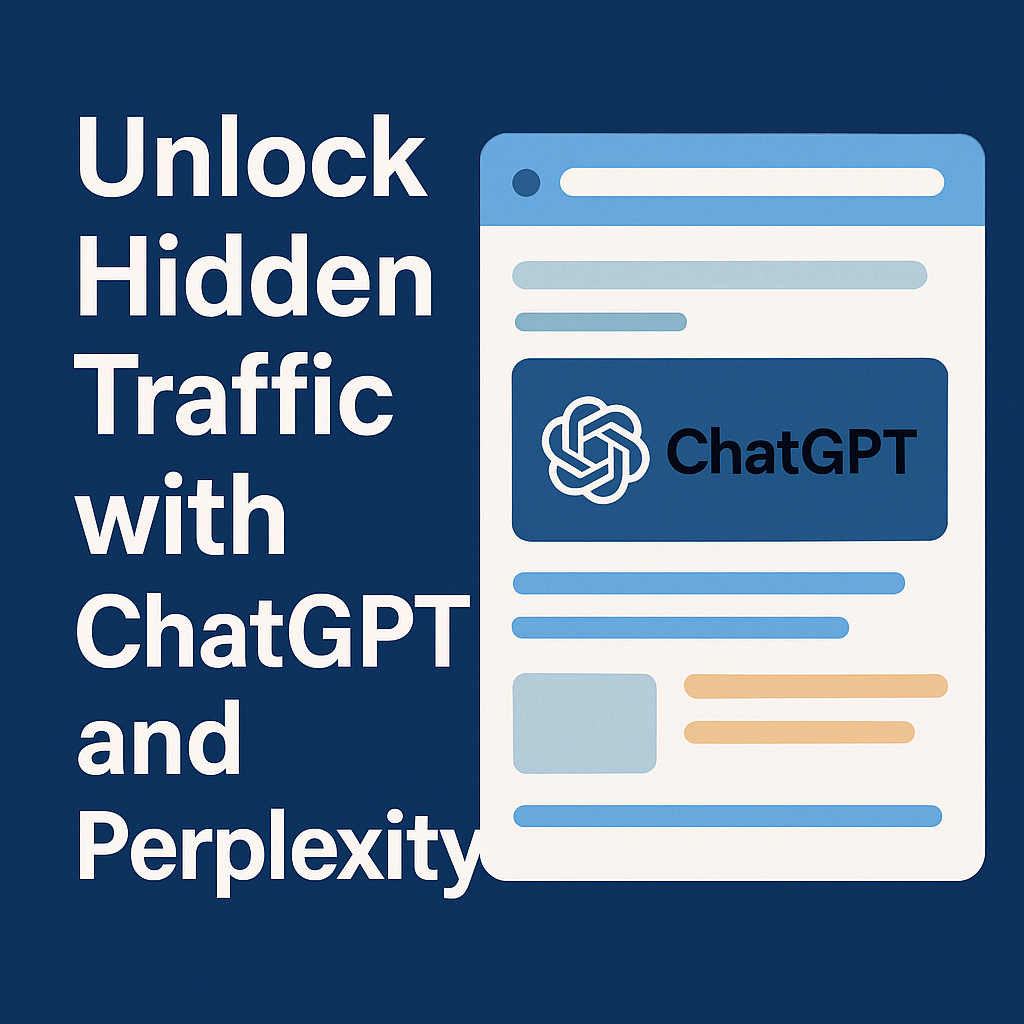Web traffic is no longer just about ranking on Google. With platforms like ChatGPT and Perplexity shaping how people search for answers, the way we think about visibility is shifting. Diversifying traffic sources is no longer optional—it’s the key to building a sustainable digital presence.
For years, businesses treated Google as the only highway for online discovery. Today, that highway is crowded, unpredictable, and expensive. A single algorithm change can send your traffic crashing. That’s why learning how to unlock hidden traffic with ChatGPT and Perplexity is so important. They represent not just a trend, but a new era of discovery that rewards clarity, trust, and creativity.
Let’s dive into ten detailed techniques that will help you diversify traffic sources, adapt to the age of AI-driven discovery, and future-proof your strategy.
Why Diversifying Traffic Sources Beyond Google Matters
Web traffic and ChatGPT are reshaping the way people find information. When someone types a query into Google, they’re met with ads, featured snippets, and endless blue links. But when they ask ChatGPT or Perplexity, they receive a conversational, direct, and curated answer. That shift means you can’t rely on traditional SEO tactics alone.
Think about it. If users start asking Perplexity for “the best CRM for small businesses,” the AI won’t show ten competing links—it will summarize, cite, and recommend. If your content is missing from that conversation, you’re invisible. The same applies to ChatGPT prompts. By learning how to diversify, you’re not just hedging against Google—you’re building a broader ecosystem of visibility.
1. Web Traffic and ChatGPT: Structure Content Around Clear Intent
Web traffic and ChatGPT thrive on clarity. The AI doesn’t just grab keywords; it understands context and intent. To optimize for ChatGPT, structure your content with human-like explanations, question-based headings, and straightforward answers.
Ask yourself: what exact questions would my audience type into an AI? Then, answer them directly within your content. A clear question, followed by a thoughtful response, increases the likelihood of being referenced in ChatGPT’s answers.
For example, if your article is about “sustainable fashion,” include sections like “What makes clothing sustainable?” or “How to choose eco-friendly fabrics?” The more direct and structured your answers, the more accessible your content becomes to AI-driven platforms.
2. Optimizing for Perplexity: Cite, Support, and Simplify
Web traffic and Perplexity go hand in hand when your content feels trustworthy. Perplexity relies heavily on sources, citations, and authority. Unlike Google, where backlinks often serve as proof, Perplexity looks at how well you contextualize and cite information.
Here’s the trick: don’t just drop facts—explain them. Use phrases like “according to recent studies” or “based on market research” to signal credibility. Add internal links to your own supporting content, and whenever relevant, link out to reputable third-party resources.
Perplexity rewards writers who combine simplicity with authority. So avoid jargon, keep sentences short, and focus on depth over fluff.
3. Email Lists: Your Traffic Anchor
When Google changes its algorithm, you lose rankings. When ChatGPT updates its model, you may disappear from responses. But when you own an email list, no platform can cut you off. That’s why email remains one of the most reliable channels for web traffic.
Start small. Offer a free guide, checklist, or newsletter sign-up tied to your core niche. Then, nurture that list with consistent value—weekly updates, insider tips, or curated resources. Remember, your email subscribers are already warm leads. They’ve given you permission to reach them directly.
The beauty of email is resilience. Even if your site drops in rankings or Perplexity skips your content, your email list continues to bring steady, predictable traffic.
4. Communities and Forums: The Human Web
Another overlooked source of web traffic is human-first communities. Places like Reddit, Quora, Discord groups, or even Slack channels create organic, trust-based engagement.
Be mindful, though. Communities can smell self-promotion from miles away. To build credibility, give first and link later. Answer questions in detail, share personal insights, and engage authentically. Over time, people will click your profile, check your content, and trust your brand.
Communities thrive on human connection. That’s exactly what Google’s algorithm, ChatGPT, and Perplexity are all trying to replicate. But here, you don’t need an algorithm—you need empathy and patience.
5. Social SEO: Turning TikTok, LinkedIn, and Instagram into Search Engines
Here’s something surprising: younger generations now use TikTok and Instagram as search engines. They type “best restaurants near me” or “how to style cargo pants” into social apps instead of Google. That’s social SEO, and it’s growing fast.
Web traffic flows to those who adapt. Start by repurposing your content into short, engaging videos. Use hashtags as keywords. Add captions that align with what people are likely to search.
Social platforms favor engagement. So, encourage comments, spark discussions, and ask questions. Unlike Google or ChatGPT, where answers are static, social platforms thrive on conversation.
6. Medium, Substack, and Third-Party Publishing
Sometimes, the best way to diversify is to publish where your audience already is. Medium, Substack, and similar platforms have built-in readers hungry for new insights.
Publishing here doesn’t replace your site—it complements it. Write an adapted version of your content, include unique intros and conclusions, and link back to your original piece.
This way, you’re not just waiting for Google rankings. You’re meeting readers halfway on platforms they trust. Medium and Substack also allow you to build authority while driving referral traffic.
7. Content Layering: The Multi-Format Strategy
Repetition is powerful. Repetition is memorable. Repetition makes your message stick.
That’s why content layering—repurposing your insights into multiple formats—is essential. Write a blog post, then record it as a podcast. Turn the podcast into audiograms. Summarize the blog into Instagram carousels. Create a short reel with highlights.
This layered approach ensures that whether your audience prefers reading, listening, or watching, they’ll encounter your message. It also multiplies touchpoints, which is crucial for diversifying traffic sources.
8. Partnering with Creators and Influencers
Web traffic and ChatGPT are influenced by trust. Influencers—especially micro-influencers—already own that trust within their niche. Partnering with them is one of the fastest ways to diversify.
But here’s the key: don’t chase numbers. A small creator with 5,000 engaged followers can bring more valuable traffic than a celebrity with a million passive fans. Collaborate on authentic content. Allow them to tell your story in their own voice.
This authenticity not only drives clicks but also creates long-term brand associations that even AI-powered platforms notice.
9. Schema and Structured Data for AI Discovery
Google isn’t the only one parsing your metadata. Perplexity and ChatGPT benefit when your content is structured cleanly. Schema markup—like FAQ, HowTo, or Article—helps AI understand your context faster.
Structured data is often overlooked, but it’s becoming vital. When AI needs a quick reference, it looks for clarity. If your content is organized with schema, you’re giving machines a roadmap.
Think of it as translating your content into a language AI understands fluently.
10. Measure and Adjust: Analytics for Diversification
Finally, none of this matters if you’re not measuring. Use GA4, Looker Studio, or independent trackers to analyze where your traffic actually comes from.
Break it down: how much is still from Google? How much is coming via ChatGPT prompts? Which Perplexity citations bring clicks? Are community forums converting better than social SEO?
The more you track, the more you can refine. Diversification isn’t static—it’s a living process of testing, learning, and optimizing.
Conclusion: The Future of Web Traffic with ChatGPT and Perplexity
The future of web traffic lies in spreading your reach across multiple platforms. ChatGPT and Perplexity are reshaping how people discover information, and those who adapt early will thrive. Google is still powerful, but it’s no longer the only player.
By using strategies like content layering, community engagement, schema markup, and creator partnerships, you’re not just chasing clicks—you’re building resilience.
Diversifying traffic sources isn’t just about numbers. It’s about independence, stability, and future-proofing your digital presence. So don’t wait until your Google rankings slip. Start now. Start with one new channel, then expand. Over time, you’ll unlock hidden traffic you didn’t even know was possible.




